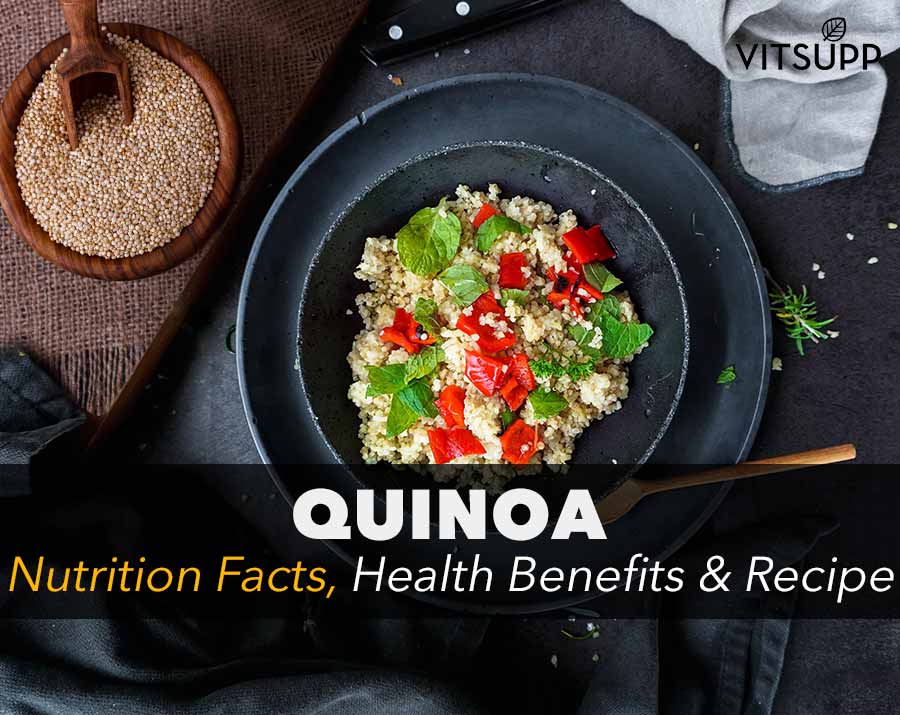Quinoa is fast gaining traction as a superfood. The United Nations declared 2013 to be the “International Year of Quinoa”, perceiving its growing popularity and nutritional benefits. In this article, I will share with you all the amazing Quinoa Nutrition Facts, Health Benefits & Recipes.
While it is already notably popular in Europe and the Americas, quinoa is almost unknown in south-east Asia. Quinoa is rich in protein, minerals, and other essential nutrients.
It is full of dietary fibers and is a good substitute for rice. It is also gluten-free, hence a popular choice for those who are gluten intolerant or who prefer foods that are free from gluten.
In this article, we highlight everything you need to know about quinoa. Let us find out more about this superfood!
Contents
What is quinoa?
Quinoa pronunciation: Quinoa is pronounced as “keen-wa”.
Quinoa is a pseudocereal, i.e, it is not a food grain, but the seed of a plant which can be eaten as a cereal.
These seeds are rich in B Vitamins, dietary minerals, dietary fibers, and proteins. When eaten, quinoa has a unique, nutty flavour, sweet taste, and a particularly distinct texture.
Quinoa was regarded as sacred by the Incas. The emperor used to sow the first seeds. However, its
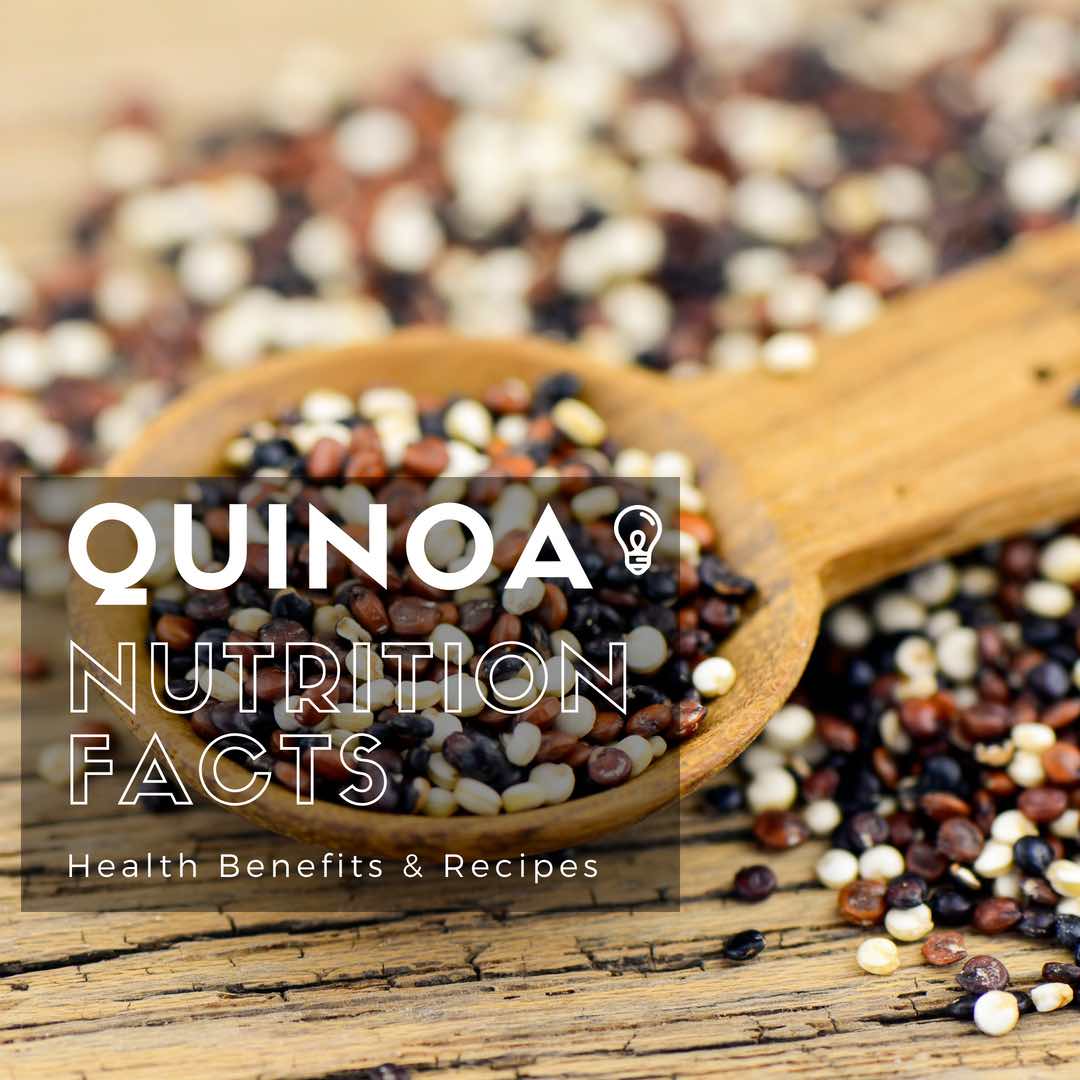
Quinoa Meaning
This grain is essentially a plant that belongs to the Amarnath family. It is a flowering plant that grows annually for the use of its seeds. The seeds are what we call quinoa. The scientific name for quinoa is Chenopodium quinoa. It is worth noting that while quinoa is a seed, it is eaten as a cereal..
This is a plant native to the Andes region of South America, where it was domesticated thousands of years ago. It has long been a staple for people residing in that region, though it was virtually unknown to the world. (Source)
Properties of Quinoa Seeds
Quinoa is the seed of a plant of the amaranth family. It is used after removing its bitter-tasting outer seed coat. In most cases, quinoa is mainly cooked like rice for consumption.
It can also be eaten raw. Quinoa is naturally gluten-free, which makes it a popular option for health enthusiasts and people allergic to gluten.
It is also rich in protein, fibers, vitamins and flavonoids, which makes it more beneficial than other staple cereals than rice or wheat. (Source)
Quinoa is also a highly durable plant and can be grown in controlled environments. It can be stored for long periods of time.
The world over, scientists have been working towards genetically modifying the plant and creating hybrids that can increase yields.
NASA selected quinoa for using in its space flights and space stations, as it is long-lasting and high in essential nutrients. (Source)
Quinoa Nutrition Facts
As mentioned above, quinoa is a pseudocereal. Most pseudocereals are similar to cereals even though they are seeds.
The fact that it is a pseudocereal means that it can be used as a whole grain.
Hence, the nutritional value of quinoa is much like that of the other whole grains.
- Quinoa is rich in essential minerals, vitamins, and fibers.
- In consuming one cup of quinoa in its cooked form (which is approximately 185 grams), you will most likely be having 222 calories, 8.14 grams of protein, 3.55 grams of fat, 5.2 grams of fibre, and 39.4 grams of carbohydrates.
- Additionally, you will also get significant amounts of folate, magnesium, manganese, phosphorus, iron, copper, zinc, and potassium.
- Traces of B Vitamins, Vitamin E, and calcium are also found in quinoa nutrition facts
- You will also be consuming a rich amount of fatty acids, such as oleic acid, and alpha-linolenic acids.
Uncooked Quinoa Nutritional Value
For a serving size of 100g, below are nutritional values: (Source)
- Quinoa nutrition 100g
- Calories: 360
- Fat: 6g
- Cholesterol: 0g
- Sodium: 0%
- Carbohydrate: 64g
- Fibre: 12g
- Sugars: 4g
- Protein: 20g
- Vitamin: 0%
- Vitamin: 0%
- Calcium: 8% of DV
- Iron: 60% of DV
- Magnesium: 50% of DV
- Zinc: 25% of DV
Cooked Quinoa Nutritional Value
For a serving size of 100g, below are nutritional values: (Source)
| Name | Amount | Unit |
| Water | 71.61 | g |
| Energy | 120 | kcal |
| Energy | 503 | kJ |
| Protein | 4.4 | g |
| Total lipid (fat) | 1.92 | g |
| Ash | 0.76 | g |
| Carbohydrate, by difference | 21.3 | g |
| Fiber, total dietary | 2.8 | g |
| Sugars, total including NLEA | 0.87 | g |
| Starch | 17.63 | g |
| Calcium, Ca | 17 | mg |
| Iron, Fe | 1.49 | mg |
| Magnesium, Mg | 64 | mg |
| Phosphorus, P | 152 | mg |
| Potassium, K | 172 | mg |
| Sodium, Na | 7 | mg |
| Zinc, Zn | 1.09 | mg |
| Copper, Cu | 0.192 | mg |
| Manganese, Mn | 0.631 | mg |
| Selenium, Se | 2.8 | µg |
Amazing Quinoa Benefits
The fact that quinoa is gaining popularity at such a fast pace can only mean that it has numerous health benefits. Let us look into the health benefits associated with this superfood.
1 Rich in protein and anti-oxidants
Quinoa is chock full of benefits. It is rich in proteins and contains all essential amino acids. It is also gluten-free and full of anti-oxidants.
Quinoa is considered a “complete protein” by many scientists. The reason it is called a complete protein is that it contains all nine essential amino acids.
Since it has a high content of protein, it is particularly recommended for vegetarians and vegans.
Additionally, it is a rich source of antioxidants. Antioxidants are responsible for neutralising all the free radicals in your body.
Free radicals can cause oxidative stress, and cause inflammation in your system. (Source)
2 Anti-inflammatory properties
Quinoa contains quercetin, which exhibits anti-inflammation properties. Additionally, as per quinoa nutrition facts, it is a powerful antioxidant
It can neutralize the effect that free radicals have on your body. This way, it can provide relief from inflammation. (Source)
3 Rich in dietary fibers
Quinoa is rich in dietary fibers, especially when taken raw. In fact, it supersedes both corn and brown rice as far as dietary fibers are concerned. (Source)
4 Quinoa Benefits in weight loss
As per quinoa nutrition facts, it is rich in proteins and dietary fibers.
Scientific evidence shows that food containing protein and fibre cuts down carb consumption, reduces snacking, aids metabolism and reduces weight.
Since it is high in protein, quinoa can also help boost your metabolism, which in turn can help with weight loss. (Source)
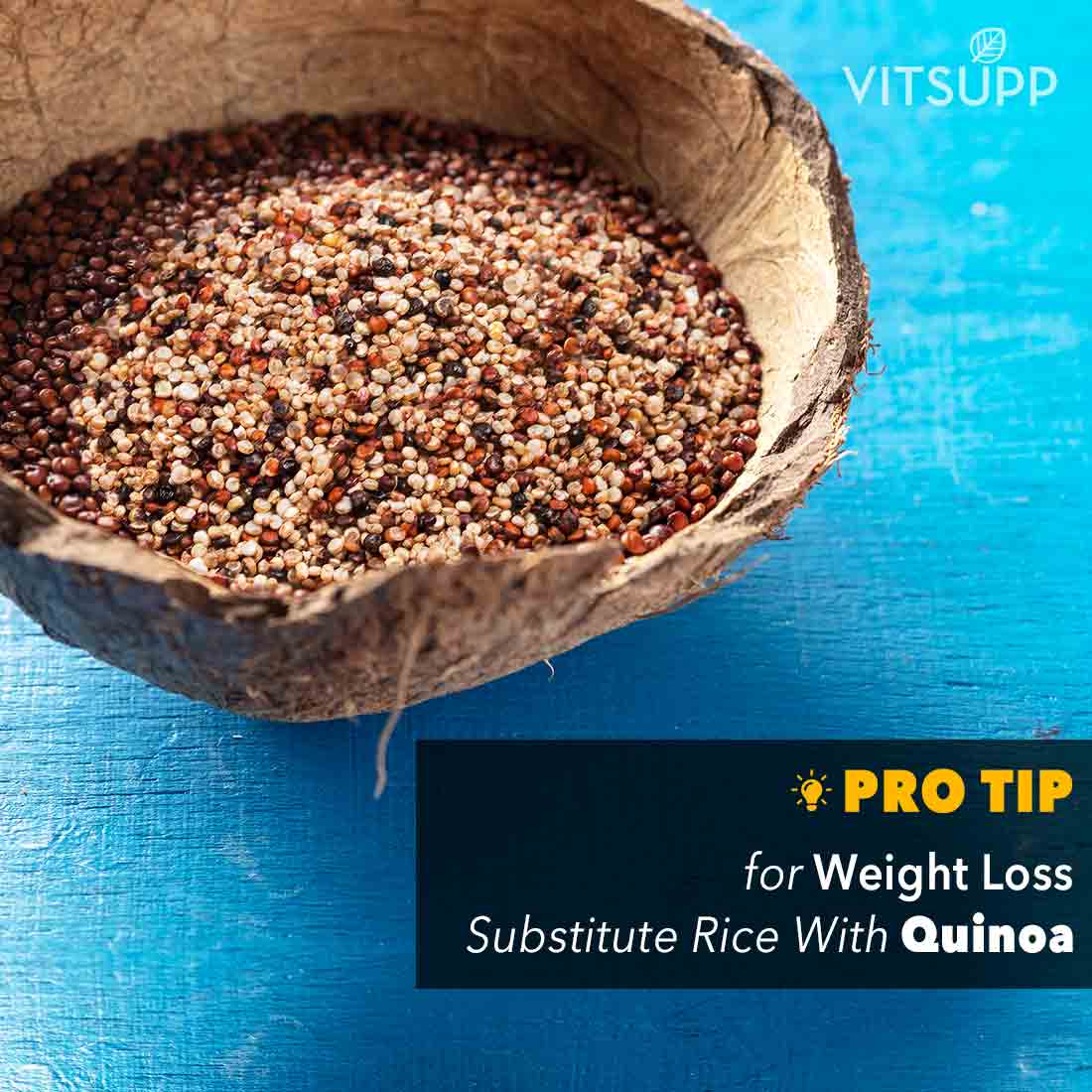
5 Quinoa Health Benefits for Diabetics
Quinoa contains a high amount of dietary fibers and is low on starch and glycemic acids. This makes it good for diabetics. Eating quinoa improves insulin sensitivity and modulates the secretion of certain gut hormones. (Source)
6 Gluten-free
Quinoa is gluten-free. In most cases, celiac-intolerant people use rice as a substitute for wheat. However, studies show that quinoa is a better substitute than rice in gluten-free diets. It is easily digestible, while its high protein, flavonoid and fibre content make it more nutritious than rice. (Source)
7 Anti-cancer properties
Studies indicate that quinoa prevents chemically-induced carcinogenic in white mice. Evidence also suggests that dietary intake of quinoa helps prevent lung cancer. Since quinoa has dominant antioxidant properties, it can help neutralize the effect of free radicals in your body and oxidative stress. Free radicals are often linked to cancer. (Source)
8 Rich in iron, zinc and calcium
Quinoa nutrition facts is a good source of iron, zinc and calcium. These minerals are available in raw, boiled and roasted forms of quinoa. (Source)

Quinoa Recipes: How to eat Quinoa
The quinoa nutrition facts suggest it can be taken raw, but mostly, it is boiled and eaten like rice. The usual method is boiling one cup of quinoa in two cups of water. A single cup of raw quinoa usually yields three cups when boiled.
It can be boiled in an open or covered pot or in a rice cooker. Check with a fork to decide the required tenderness after boiling for 15 minutes.
Quinoa can be used as a substitute for rice. It can be added to soups or stews to make them more filling. It can be used as a stir-fry base instead of rice. Quinoa can also be used as a substitute for pasta. It can also be used in a variety of salads. (Source)
Quinoa flour recipes
Quinoa can also be ground and used as flour. However, bread and baked goods made with quinoa flour are coarser, less fluffy and have a bitter aftertaste. (Source)
How to Make Quinoa Tasty – Quinoa Recipes
Quinoa can be quite the delicacy is you make it the right way. Here are a few quinoa recipes you can try out for yourself-
Easy Quinoa Salad Recipe
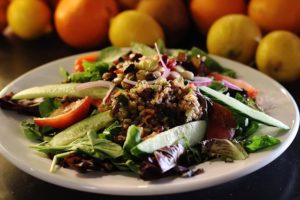
Ingredients
- 1 cup quinoa
- 1 1/4 cups water
- 1 lemon, juiced (about 2 tablespoons)
- 1 garlic clove, minced
- 1/4 teaspoon ground black pepper
- 2 tablespoons olive or canola oil
- 1 large cucumber, seeded and cut into 1/2-inch pieces
- 1 pint cherry tomatoes, halved
- 1/3 cup chopped parsley
- 1/4 cup chopped red onion
- 1/2 cup reduced-fat feta cheese
Preparation
- Boil the quinoa for around 10 minutes. Fork to check tenderness. Drain excess water.
- Spread it out on an open surface to dry and cool.
- In a bowl, mix the lemon juice, garlic, pepper and oil. Whisk to make a dressing.
- Take a bowl and toss the quinoa and the vegetables. Pour in the dressing and toss to mix evenly. Serve. (Source)
Quinoa risotto with arugula and parmesan

Ingredients
- 1 tablespoon olive oil
- 1/2 yellow onion, chopped (about 1/2 cup)
- 1 garlic clove, minced
- 1 cup quinoa, well rinsed
- 2 1/4 cups low-sodium vegetable stock or broth
- 2 cups chopped, stemmed arugula (rocket)
- 1 small carrot, peeled and finely shredded
- 1/2 cup thinly sliced fresh shiitake mushrooms
- 1/4 cup grated Parmesan cheese
- 1/4 teaspoon salt
- 1/4 teaspoon freshly ground black pepper
Preparation
- Rinse the quinoa.
- In a saucepan, heat olive oil and saute the onion until translucent.
- Add garlic and quinoa. Don’t let the garlic brown.
- Add the stock and bring to boil. Reduce the heat and check the quinoa. It should be soft and slightly hard in the centre.
- When the consistency is broth-like, stir in the arugula and carrots. Cook for a couple of minutes until the quinoa looks white or translucent.
- Stir in the cheese, salt and pepper. Serves six portions. (Source)
How to Cook Quinoa Pasta
Ingredients
- 1 egg
- Sea salt – ½ teaspoon
- Quinoa Flour – 1 cup
Preparation
- First, break the egg into a clean bowl and add the salt. You will have to gently whisk the mixture.
- To this, add the quinoa flour. Mix well until a dough mixture is formed.
- You will then have to roll out the dough and flatten it to form a shape of a rectangle. Once this has been done, use a pizza cutter or knife to cut the dough into the shape of your pasta.
- Your quinoa pasta is ready.
- You can boil this and make your own pasta based on your preference of sauce.
How to make Quinoa Patties
Ingredients
- Two and a half cups of cooked quinoa
- 4 eggs
- 1 onion, chopped finely
- One-third cups of grated parmesan cheese
- 3 pods of garlic
- One cup of breadcrumbs
- 1 spoon of olive oil
- Salt to taste
Preparation
First, mix the quinoa, salt, and eggs in a clean bowl. To this, you will have to add the onions and garlic, and finally, the grated cheese. Mix this well. Then, add in the bread crumbs. Let this mixture sit for a while so that the bread crumbs can absorb any moisture that might be present. After a while, you will have to make small patties with this dough.
In a pan, add a few drops of olive oil and once the oil is hot, place around four to six patties based on the size of your pan. Shallow fry the patties. Once it turns a nice shade of golden brown flip the patties over to the next side. Your patties are ready!
Quinoa Recipes – Indian
We’ve added some quinoa recipes with a desi touch as well! Read on…
Quinoa and mixed vegetable pulav
Quinoa can easily be used as a substitute for rice. You can use boiled quinoa instead of rice while making pulav. You can easily make a vegetable quinoa pulav. Here is an easy recipe, from Sanjeev Kapoor.
Ingredients
- 2 cups quinoa, soaked and drained
- ½ cup shredded spinach
- 1 medium onion, sliced
- 1 medium carrot, roughly chopped
- 5-6 button mushrooms, roughly chopped
- 5-6 French beans, roughly chopped
- ¼ cup corn kernels
- 1 tablespoon oil
- Salt to taste
- 1 teaspoon cumin seeds
- 1 teaspoon red chilli powder
- ¼ teaspoon turmeric powder
- 1 teaspoon garam masala powder
Preparation
- Heat oil, add cumin seeds. When they are fried and release aroma, add in onions and saute until translucent.
- Add carrots, beans, corn kernels, mushrooms and salt. Saute on high heat for 2-3 minutes.
- Add quinoa, mix well with vegetables.
- Add turmeric, chilli and garam masala powder. Mix well.
- Add spinach and 3 cups of water. Boil until quinoa is completely done.
- Serve hot.
Quinoa Poha
Here is another easy quinoa recipe by Sanjeev Kapoor.
Ingredients
- 1 cup quinoa
- 2 tablespoons oil
- ½ teaspoon mustard seeds
- 8-10 curry leaves
- 2 medium onions, chopped
- ¼ teaspoon turmeric powder
- 2 green chillies, chopped
- 2 small potatoes, boiled, peeled and cut into 1 cm cubes
- Salt to taste
- 2 tablespoons roasted and crushed peanuts
- 1 tablespoon chopped fresh coriander
- 2 tablespoons scraped fresh coconut
Preparation
- Rinse and boil quinoa in two cups of water. Cover after 20 minutes.
- Heat oil, add mustard seeds. When they start to sputter, add curry leaves and saute.
- Add onions. Saute until golden brown.
- Add turmeric powder and green chillies. Saute well.
- Add boiled potatoes, mix well.
- Add boiled quinoa. Salt and mix well.
- Take it off the pan and let it cool for a while. Mix in peanuts, coconut and coriander. Serve hot.
How to cook quinoa in a rice cooker
You can easily use quinoa as a substitute for rice – it is definitely a healthier option. The best part is, you can make it easily in your rice cooker Here is how you do this –
Ingredients
- One cup of quinoa
- Two cups of water
- Half a spoon of salt
Preparation
First, rinse your quinoa in water to remove any impurities that might be there. Put the quinoa in a rice cooker and add two cups of water. You will then have to add the salt. Close the lid of the cooker and put the whistle. Your quinoa should be done in around twenty to thirty minutes. In most cases, this will be around six to eight whistles. Please note that quinoa, when boiled, increases in size. Therefore, one cup of quinoa before boiling will make three to four cups after it has been boiled.
Is Quinoa Actually Better For You Than Rice?
Gone are the days when you are stuck with a handful of healthy food options to replace your diet. Quinoa is one of such healthy options that is taking over the new-age health-conscious individuals. If you are planning to replace your rice with it, you should consider a few points. The carbs in quinoa vs rice vary to a certain extent. Quinoa has low carbohydrates. Hence, it is a healthier choice.
As for the quinoa vs rice calories, there are various types of rice to consider. Quinoa has almost similar calories as brown rice or red rice. However, white rice has fewer calories compared to quinoa. Therefore, in terms of calories present in a cup of both types of grains, quinoa scores slightly higher than rice.
Meanwhile, when it comes to rice vs quinoa nutrition facts, the latter stays ahead. Quinoa is highly nutritious and has more protein and fiber content. As for the rice vs quinoa protein, one cup of quinoa has higher protein levels than a similar quantity of rice. Hence, despite the calorie factor, quinoa nutrition facts make it a healthier option that is better for you.
Quinoa Or Oats Which Is Better
While quinoa is becoming more popular with passing time, the individuals who are depending on healthy food options like oats are finding themselves torn between the two super foods. If you are looking for a gluten-free option, quinoa is the appropriate choice. Also, the high quinoa protein amount makes it a better choice for individuals searching for a healthy, protein-rich meal.
As quinoa and oats are both good for cardiovascular health, the oats can be slightly better in this context. Quinoa also boosts your gut health. It is a great source of various minerals, which also makes it superior to oats. You can incorporate both in your diet, i.e., overnight oats for breakfast and quinoa with vegetables for lunch. This helps you to get the most of these healthy foods.
Quinoa In Ayurveda
Unlike other traditional food, quinoa is a modern crop that can be utilized based on Ayurvedic purposes. When it comes to the Ayurvedic profile of quinoa, the Rasa (taste) is slightly sweet. It has a cooling Vriya (energy) and gives a somewhat dry feeling to Vipaka (Post-digestive effect). As for the qualities or Gunas, the quinoa nutrition chart can go a long way.
The dosha effects of this crop encompass Vata, Kapha, and Pitta. Quinoa is dry; the Vata dosha can aggravate if one eats it without soaking it in anything. It is light and has no mucus formation, which allows it for moderation under Kapha dosha. Due to the soothing and non-inflammatory aspects of quinoa, it can be linked to the Pitta dosha.
Quinoa is gluten-free and perfect for kapha-dominated or sensitive constitutions. Due to the high protein content of quinoa, it can work great in controlling the Vata dosha. It must be balanced with the right amount of fat for this purpose. Alkalization of this crop helps to combat the acidity of Pitta. The quinoa protein per cup is higher than its other substitutes, which helps for the rejuvenation of the dhatus.
It pacifies Agni, which is connected to digestive health. Due to its light texture, it can be easily disestable with the right amount of spices. However, it avoids further aggravating the Vata dosha. However, overconsumption may affect one’s digestive power, overpowering quinoa nutrition facts.
Conclusion
Quinoa is a great fruit that is stocked full of proteins, vitamins, minerals and fibers. It is gluten-free and ideal for diabetics. You can easily use quinoa instead of rice while making pulao, upma, and poha. Similarly, it forms a great alternative for pasta, and can easily be used as a base for stir fry and salads. You can try introducing quinoa by starting with these recipes. Thanks to its popularity, you will find quinoa in most food stores.
It is safe to say that quinoa is one of the world healthiest foods. This health food can reduce the risk of type 2 diabetes, facilitate blood sugar control, prevent cancer, and a whole other list of health benefits.
FAQs on Quinoa
Q1. What is quinoa?
Quinoa (pronounced keen-wa) is a pseudocereal, i.e, it is not a food grain, but the seed of a plant which can be eaten as a cereal. It is a plant native to the Andes region of South America, where it was domesticated thousands of years ago. (1)
It is obtained from the Chenopodium quinoa plant. Quinoa seeds benefits are the key reasons behind its wide consumption among customers. It is being considered as a substitute for rice, oats, etc. Quinoa vs rice nutritional value differences make it one of the key preferences of the health-conscious customer segment. In the meantime, this grain is linked to Ayurveda. Quinoa is known for pacifying certain Ayurvedic doshas like Vata, Pitta, and Kapha.
Q2. Is quinoa gluten-free?
Quinoa is naturally gluten-free, which makes it a popular option for health enthusiasts and people allergic to gluten. It is also rich in protein, fibers, vitamins and flavonoids, which makes it more beneficial than other staple cereals than rice or wheat. (3)
Individuals who suffer from celiac disease can opt for this gluten-free super food. It is easy on the stomach and helps to cool down digestive issues. It is advisable to find the ‘certified gluten-free’ label on the packaging before making the final purchase, as some processed food companies may sell you otherwise. This will help gluten-intolerant customers prevent life-threatening health problems.
Q3. What is quinoa flour?
Quinoa nutrition data is not an unknown fact. It is healthy, irrespective of which form you choose to consume it. However, it is important to refrain from eating it dry. This grain can also be ground and used as flour. However, bread and baked goods made with quinoa flour are coarser, less fluffy, and have a bitter undertaste. (14)
With all the protein, fiber, vitamins, and minerals, quinoa flour is an ideal alternative to regular wheat flour. The high protein content of quinoa makes it superior to other types of flours obtained from wheat, oat, and almond. This gluten-free flour can aid in digestive wellness.
Besides providing sustained energy, meals made from this flour can improve the cardiovascular and muscle health of the consumers. Regarding the recipes for quinoa flour, it can be mixed with other types of flours and baked into breads or cookies. It works great as a binding agent when making burgers or similar food. Quinoa flour can also be used as a thickening agent in gravies and soups. However, due to its dry nature, this flour can consume more liquids than other flours.
Q4. Is quinoa rich in proteins?
Quinoa protein amount is high, and hence, if you are looking for a protein-enriched meal, this grain is the perfect choice for you. It has more protein than any other substitute, making it one of the key preferences of health-conscious customers.
It is rich in proteins and contains all essential amino acids. It is also gluten-free and full of anti-oxidants. Quinoa is considered a “complete food” by many scientists. (5)
Quinoa nutrition facts refer to it as a complete protein due to the existence of nine essential amino acids. All these cannot be produced by the human body. Hence, they must be sourced from various food and ingredients. Therefore, 100g cooked quinoa nutrition facts make it more preferable, especially to vegans and vegetarians.
Q5. Does quinoa make you lose weight?
When you lean towards meals made from quinoa, it healthifies you in many ways. One of the major benefits is aiding in weight loss. It can make the consumer feel full and keep them from indulging in frequent snacking. This helps to prevent obesity among individuals and enables them to manage their weight more efficiently.
As quinoa is rich in proteins and dietary fibres. Scientific evidence shows that food containing protein and fibre cuts down carb consumption, reduces snacking, aids metabolism and reduces weight. (8) Try Quinoa for weight loss and let us know your experience.
One of the quinoa fun facts is that this grain can help to reduce belly fat through supporting metabolism. The low glycemic index in quinoa supports the managing blood sugar. This helps to prevent weight gain caused by blood sugar spikes. Try Quinoa for weight loss and let us know your experience.
Q6. Is quinoa good for diabetes?
Quinoa contains a high amount of dietary fibers and is low on starch and glycemic acids. This makes it good for diabetics. Eating quinoa improves insulin sensitivity and modulates the secretion of certain gut hormones. (9) Quinoa has a low glycemic index that helps with blood sugar management. Therefore, weight gain caused by a spike in blood sugar levels can be prevented by incorporating quinoa in one’s diet. It improves insulin sensitivity, which helps to manage diabetes. The high fiber in quinoa controls hunger pangs. It enables the consumer to limit their calorie intake and adopt a healthy diet. Try Quinoa for diabetes and let us know your experience.
Q7. Can quinoa prevent cancer?
Studies indicate that quercetin in the diet prevents chemically-induced carcinogenic in white mice. Evidence also suggests that dietary intake of quercetin helps prevent lung cancer. (11)
Bioactive compounds present in this grain can help with cancer management. As it is rich in antioxidants, it can combat inflammation and oxidative stress. Studies have shown that both of these are linked to the development of cancer. The high fiber content in quinoa can improve gut health and ensure a healthy gut microbiome. This is reportedly associated with cancer prevention (For certain types). However, this needs further scientific research to gain full consideration.
Q8. How to eat quinoa?
Quinoa can be taken raw, but mostly, it is boiled and eaten like rice. Quinoa can be used as a substitute for rice. It can be added to soups or stews to make them more filling. It can be used as a stir-fry base instead of rice. Quinoa can also be used as a substitute for pasta. It can also be used in a variety of salads. (13)
Eating dry quinoa is not recommended. Hence, it is advisable to soak it in liquids to make it softer and fluffier. It is a great replacement for rice due to its lower carbs and higher fiber, thereby helpful for gut health and weight management. One can also have quinoa for lunch, especially for vegans and vegetarians. It can be eaten with a lot of vegetables to multiply the health benefits of quinoa. One can also eat it as a breakfast cereal. Quinoa seeds benefits go further as they help to deal with diabetes.
Q9: Where can I buy Quinoa in India?
While Quinoa is not native to India. It is not readily available in every food and grocery store due to its amazing health benefits. It is also available in Amazon.
Although quinoa originally belongs to South America, it is slowly becoming popular in our country. As the new-age customers are highly health conscious and the older population are choosing a healthy diet to avoid medical complications, quinoa plant has become popular.
Besides supermarkets and hypermarkets, quinoa is available in popular online stores as well. Looking at the growing trend towards healthy eating, it is expected that more small-sized eCommerce stores will start selling quinoa. With the rising adoption of this grain, some local shops are also keeping it in stock to retain their health-conscious customers.
Q10: What is the name of Quinoa in Tamil?
Unlike what many of feel when we see Quinoa, it is not a grain. It is a pseudocereal, i.e, it is not a food grain, but the seed of a plant which can be eaten as a cereal.
The appearance of Quinoa is similar to the millets and lot of people in Tamilnadu think it is a native crop to Tamilnadu.
However, Quinoa is not native to India, it has completely different characteristics and profile.
As it is not native to India it has no Indian or Tamil name.
Q11: Can I eat quinoa every day?
Yes, you can eat Quinoa everyday.
I have personally consuming Quinoa flour every day for the last 2 years along with my 10-year-old son and have never faced any digestion problem.
Quinoa is a protein-rich grain that can be combined with various vegetables and turned into a healthier meal. If you have dietary restrictions that keep you from having quinoa on a daily basis, it is better to avoid overconsumption.
This grain should also be avoided if you are suffering from extreme digestive issues. Although rare, individuals who are allergic to quinoa should avoid having it.
Q12: How much quinoa should I eat?
Excess of any food item is bad. You should sr=trive for a balanced diet.
You can slowly introduce Quinoa to see if it is fine with your digestion system and in my experience, everyone can digest it easily.
Once you feel comfortable with a certain quantity of it, you should follow that measurement only. This will come from daily consumption for a long time.
If you feel that overconsumption is not suitable for you, it is advisable to limit your quinoa intake. Regular consumption should be transformed into occasional eating in this context.
Q13: Can celiacs eat quinoa?
Yes, Quinoa is naturally gluten-free and therefore people suffering from celiac disease can easily eat it. (Source)
If you are purchasing from outside, it is advisable to check for a certified label. If anyone with celiac disease consumes market-bought quinoa without that label, he or she will be at a risk of cross-contamination.
Quinoa is enriched with protein, fiber, vitamins, minerals, and essential amino acids. Hence, this highly nutritious food option can be great for celiacs. However, it is essential to maintain the quantity as overconsumption may lead to health complications.
Q14: What is the name of Quinoa in Telugu?
Unlike what many of feel when we see Quinoa, it is not a grain. It is a pseudocereal, i.e, it is not a food grain, but the seed of a plant which can be eaten as a cereal.
The appearance of Quinoa is similar to the millets and lot of people in Telangana think it is a native crop to the state.
However, Quinoa is not native to India, it has completely different characteristics and profile.
Quinoa in telugu meaning and benefits are numerous. As it is not native to India, it has no Indian or Telugu name.
Q15: How to pronounce quinoa?
It is pronounced as “keen-wa”. As the crop does not have its roots in India, a mispronunciation is inevitable, especially in a country that is home to people from various religions and communities.
Even if you are unable to pronounce quinoa correctly, it will not make any difference unless you can make the shopkeeper understand the grain you are looking for. However, it is always advisable to call a grain by its correct name to avoid confusion.
Q14: Can you eat quinoa by itself?
Yes, you can. Be it quinoa cereal or salad, quinoa remains the central ingredient in any recipe that includes it. As for the breakfast, it is soaked in milk like regular cereal and eaten soft.
However, it is important to rinse the grain thoroughly before eating it raw. Otherwise, it will taste bitter due to an outer layer. Cooked quinoa nutrition facts 100g can be used as a base for many healthy recipes. It does not tamper with the taste while enhancing the health benefits of that dish.
Q15: Can you eat quinoa raw?
If you want to consume Quinoa raw then you must soak it in water and sprot it before you consume. I am personally not aware of any documentation if it can be eaten raw otherwise.
I am recommending the consumption of raw Quinoa as sprouted seeds and grains have higher nutritional value compared to its dry version. Sprouting breaks down the phytate present in the grains that normally decreases absorption of vitamins and minerals in the body. (Source)
I also recommend you to always cook Quinoa instead of eating it raw. In fact Quinoa will taste better if you cook it before eating it. as it will bring out the flavours.
Q16: What are the most popular ways to eat quinoa?
You can eat Quinoa is multiple ways, you can make bread (including Indian bread or Paratha), replace rice with it and even eat it in the salad.
Q16: What are the most popular ways to eat quinoa?
You can eat Quinoa in multiple ways; you can make bread (including Indian bread or Paratha), replace rice with it, and even eat it in a salad.
Quinoa flour is a great substitute for regular flour. You can mix it with almond, wheat, or oats flour and bake bread for daily consumption. However, it requires more water than its counterparts. Quinoa seeds benefits are known to all. One can simultaneously eat brown rice and quinoa to ensure a healthy yet filling meal. Quinoa rice can be eaten in lunch after combining it with different vegetables. This way, the nutritional value of the dish will increase. As for salad or pasta, quinoa goes a long way as a base. It is light yet filling, therefore reducing snacking, and works as a complete meal.
Q17: What is the name of Quinoa in Marathi?
Unlike what many of feel when we see Quinoa, it is not a grain. It is a pseudocereal, i.e, it is not a food grain, but the seed of a plant which can be eaten as a cereal.
The appearance of Quinoa is similar to Amaranth and it is part of the amaranth family. Therefore a lot of people in Maharastra think it is a native crop to the state.
However, Quinoa is not native to India, it has completely different characteristics and profile.
As it is not native to India it has no Indian or Marathi name.
Q18: Quinoa vs rice, which is better?
In this era of healthy living, the new-age population is hovering over the super foods. As for the quinoa nutrition vs rice, it is important to consider all the nutritional factors before making the final judgment. While quinoa is richer in protein and fiber, it has slightly higher levels of calories. Also, quinoa has fewer carbs than rice, making it a healthier choice. However, it is essential to analyse quinoa vs rice nutrition facts 100g to conclude which one is better. Let us look at a detailed comparison of uncooked quinoa and brown long-grain raw rice.
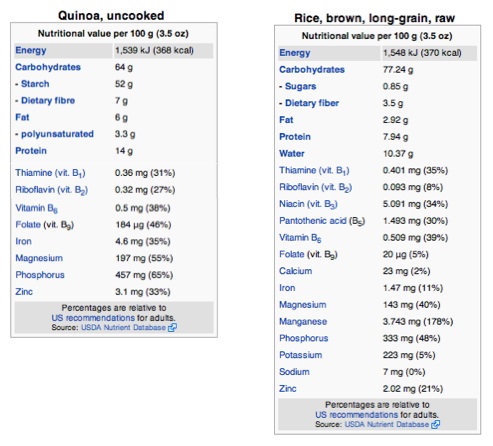
Q19: What is quinoa price in India per kg?
Quinoa grain can be bought easily in India between Rs 200/kg to Rs 300/kg depending on the source and variety.
The price of quinoa in India varies depending on different factors. The cost of organic quinoa is higher due to its superior quality. Also, a renowned brand selling quinoa is likely to charge less due to mass production. In the meantime, for new businesses, the cost will be higher. There will be a significant difference in prices between packaged and loose quinoa per kg. The price can go as high as 600/kg if you are opting for a finer quality of grain. Hence, there is no specific price range for this super food. With VitSupp, you can learn more about this grain.
Q20: Do I need to wash Quinoa before consumption?
Quinoa should always be pre-washed if you want to add it to your meal, as it contains remnants of bitter-tasting saponins, which act as a natural pesticide.
Like any other food grain, quinoa needs a thorough wash before using it as an ingredient for your meal. Besides removing the dirt, the wash also helps to eliminate a coating of saponin. It tastes bitter and is not good for health.
Therefore, it is essential to have it thoroughly washed to ensure that every trace of that coating is removed. Also, if that outer layer remains, the dish will taste bitter.
Q21: Is it good to eat quinoa every day?
Quinoa is a healthy food that can be consumed daily without any side effects. However, eating the same type of food daily may keep you from exploring various options. Different types of meals allow an individual to gain a broader range of nutrients. Quinoa nutrition facts 100g cooked highlight the enormous health benefits of this food.
- Quinoa is enriched with protein, fiber, essential amino acids, and various antioxidants – making it a highly nutritious food choice.
- Regular consumption can improve gut health, boost digestive power, and regulate blood sugar levels.
- As quinoa is gluten-free, it can aid individuals with gluten intolerance or celiac disease.
- It improves cardiovascular health by reducing triglyceride levels. For more such information, follow VitSupp.
Q22: What is the Indian name for quinoa?
It is called quinoa in English. This crop is originally from South America. Due to a rising trend in healthy eating habits, it has recently been introduced to the Indian market. As it has climbed up the popularity ladder quickly due to its immense health benefits, it has become popular by the English name ‘quinoa’. However, there are some local names by which it is recognised in various parts of the country.
The local Indian name of quinoa is Kīnōā (Hindi) or Kiṉōvā / Kvinōvā (Southern region). Therefore, it can be said that most of the Indian customers know about quinoa by its global name. So, if does not have any specific Indian name. Keep following VitSupp for more information.
Q23: What are the benefits of quinoa recipes?
Most people opt for quinoa as they prefer something healthy. The various recipes of quinoa help these individuals get a taste of health without feeling bland or getting bored by the plain flavour. Everyone knows quinoa nutrition facts. Quinoa protein amount is huge, making it an ideal food to consume.
Whether you are having a salad or pasta made from quinoa, it will be rich in fiber. It will help with digestion and allow an individual to analyze the quinoa vs rice fiber. It is also a protein-packed crop. Quinoa protein per cup is higher than that of white or any other rice, making it an ideal meal choice.
While carbohydrates in quinoa per 100g is lower than any of its substitutes, i.e., rice, it is essential for health-conscious individuals to opt for various recipes for a change of palette. Therefore, a quinoa salad recipe can save you from unwanted carbs while keeping your digestive system smooth. Keep following VitSupp for more.
Q24: What is the healthiest way to eat quinoa?
When it comes to maximizing the health benefits of quinoa, it is important to choose a recipe that will help you obtain the goodness of various nutrients. A quinoa salad recipe goes a long way in this context. You can add as many fresh vegetables as you want to make it healthier.
From green leafy vegetables like spinach to colorful cherry tomatoes, the more types of vegetables or fruits the salad has, the further its goodness multiplies. Even for the dressing, it is essential to choose a healthy option that blends well with the contents and enhances the flavour while keeping your system clean.
The quinoa seeds benefits are also considered one of the key aspects of its growing popularity. It can be eaten as a healthy alternative to regular breakfast cereals. Once these seeds are added to the milk, they become fluffy and soft. Hence, this recipe can be opted for an effortless breakfast. VitSupp can bring you more insightful information on healthy food choices.
References:
- Quinoa (Chenopodium quinoa Willd.): composition, chemistry, nutritional, and functional properties NCBI
- Lost crops of the Incas: little-known plants of the Andes with promise for worldwide cultivation National Academy Press
- Nutrition facts and functional potential of quinoa (Chenopodium quinoa willd.), an ancient Andean grain: a review NCBI
- Quinoa breaches the boundaries of outer space FAO
- Total antioxidant capacity and content of flavonoids and other phenolic compounds in canihua (Chenopodium pallidicaule): an Andean pseudocereal NCBI
- Quercetin transiently increases energy expenditure but persistently decreases circulating markers of inflammation in C57BL/6J mice fed a high-fat diet NCBI
- Properties of starch and dietary fibre in raw and processed quinoa (Chenopodium quinoa, Willd) seeds NCBI
- Effect on blood lipids of very high intakes of fibre in diets low in saturated fat and cholesterol NCBI
- Metabolic effects of dietary fibre consumption and prevention of diabetes NCBI
- In vitro starch digestibility and in vivo glucose response of gluten-free foods and their gluten counterparts NCBI
- Multitargeted cancer prevention by quercetin NCBI
- Effects of roasting and boiling of quinoa, kiwicha and kañiwa on composition and availability of minerals in vitro NCBI
- The Nutrition Source Harvard Health
- Quinoa flour in baked products NCBI
- Quinoa Salad Mayo Clinic
- Quinoa risotto with arugula and parmesan Mayo Clinic
.

